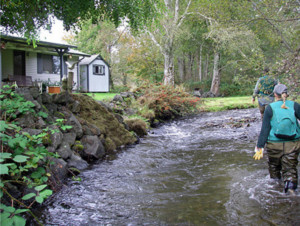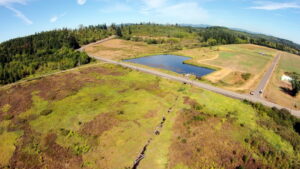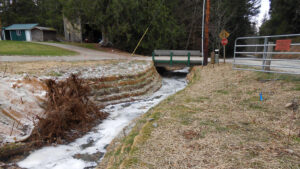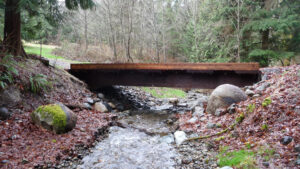
WFC staff replaced the failing 2-foot culvert with a 15-foot wide concrete bridge that will provide a huge increase in flow capacity and provide wild salmonids access to critical spawning and rearing habitat upstream from the project site.

Spawning surveys were conducted in Kitsap and Pierce County to identify pre-spawn mortality in coho.

Collection and synthesis of fish-distribution data for evaluation of fish-passage effectiveness at a retrofitted tide gate at the mouth of Maxwelton Creek on Whidbey Island in Puget Sound.

WFC conducted a rapid watershed assessment, analyzed the current status of salmon stocks, and developed a comprehensive suite of restoration actions intended to quickly improve habitat conditions for native wild fish in the Little Quilcene River basin

Wild Fish Conservancy developed and installed a digital video surveillance system to monitor upstream fish passage at the French Slough Flood Control Facility near Snohomish, Washington.

WFC ground truthed and corrected water type classifications in approx. 90 mi of streams that drain the Gig Harbor Peninsula. Additionally, WFC filled critical data gaps on ESA-listed fish species composition and distribution via field observations and through the use of environmental DNA (eDNA).

This project removed an undersized culvert which crossed under a private forest land road. The culvert was 67% passable and was replaced with an 18′ by 15′ by 7′ concrete box culvert. This project improved access to 5.43 miles of upstream spawning and rearing habitat for coho, and cutthroat, steelhead, and bull trout.

The project goal is to improve wild fish access to over ten miles of habitat that has been blocked for several decades, restoring a self sustaining wild salmon and steelhead population to Gheer Creek while providing an excellent outreach and education opportunity for the community. In addition to implementing fish passage improvements, Wild Fish Conservancy will work long-term with WA Department of Fish and Wildlife to ensure hatchery practices in Gheer. Creek are compatible with wild fish recovery efforts there.

Removal of a fish passage barrier on this tributary to the Skookumcheck River that will allow salmonids to migrate up and downstream to spawn and rear on habitat that is opened as a result of the removal of this barrier and replacement with a fish passable structure.

This project removed four undersized and ill-angled culverts, which were a barrier to fish passage due to the high velocity of water running through them. These culverts were replaced with one 16′ wide, 8′ high and 20′ long concrete box culvert that improved the spawning and rearing habitat for coho, olympic mudminnow and both cutthroat and steelhead trout for up to 5.14 miles upstream.

During summer 2011 WFC removed the barrier culvert and intalled a 14′ x 30′ steel bridge. A short section of the channel was realigned to
improve alignment with the road, and bioengineering techniques were used to stabalize the affected banks. During fall 2011, WFC observed
several pairs of adult coho upstream from the new bridge.

This project removed two barrier culverts and improved access to 0.7 miles of coho, cutthroat and steelhead habitat up to the headwater lake. The first barrier was a culvert with a 3.27% slope (67% passible) and was replaced with a 5.5ft high, 12ft wide and 12ft tall concrete box. The second barrier had a 1 meter outfall drop (0% passible) and was replaced with a 40ft long steel bridge.

To accomplish the restoration goals, approximately 2,100 lineal feet of bank armorment along the right bank was removed, the bank was re-sloped to the natural shoreline gradient, flood fence poles were installed on the uppermost bench of the river bank area, native trees were planet, and a failing culvert was replaced.

WFC removed the undersized culverts and installed a 13’x12’x6′ precast box culvert to restore the passage of fish, water, sediment, and wood through this stream reach.

This project removed an undersized, 33% passable, culvert and put in a 40′ long, 14′ wide steel bridge. This project improved 4.45 miles spawning and rearing habitat for coho and steelhead and cutthroat trout.

Project partner Natural Resources Conservation Service (NRCS) designed and constructed fish passage improvements at the culverts at both crossings, removing the undersized culverts and replacing them with steel bridges. WFC designed and implemented a bank stabilization project using extensive coir wrapping, large woody debris (LWD) placement, and native riparian planting.

WFC removed a partial barrier to fish passage (two undersized round culverts) at the Kuhlmann Property on Thomas Creek and installed a
10′ span x 12′ long x 5′ high precast box culvert.

Snyder Cove Creek is a perennial, fish-bearing watershed that flows into the east side of Eld Inlet. It offers excellent spawning and rearing habitat, and currently supports populations of cutthroat trout, sculpin, and lamprey. An undersized (3ft diameter) culvert creates a barrier to the upstream migration of fish, effectively blocking almost one mile of fish habitat.

WFC staff replaced the failing culvert with a 34-foot wide wooden bridge and added large woody debris (LWD) and rock weirs that will provide a huge increase in flow capacity and provide wild salmonids access to critical spawning and rearing habitat upstream from the project site.

WFC staff replaced an undersized partial-barrier culvert with a 35′ long by 16′ wide modular steel bridge. Minor in-channel work was performed to provide a consistent gradient through the project reach, and LWD was added to increase instream habitat complexity. Disturbed areas were replanted with native trees and shrubs.
Join our mailing list to recieve important updates on our work, the latest wild fish news, & opportunities to take action to support wild fish.
This site is protected by reCAPTCHA and the Google Privacy Policy and Terms of Service apply.
Wild Fish Conservancy is recognized as a 501(c)3 non-profit by the IRS